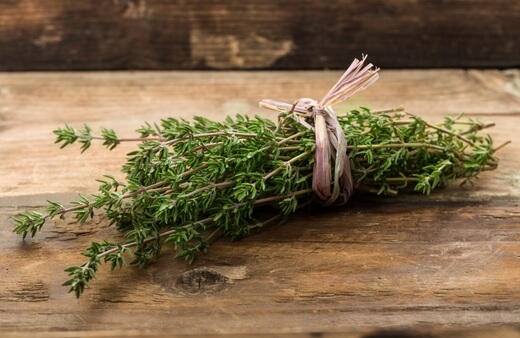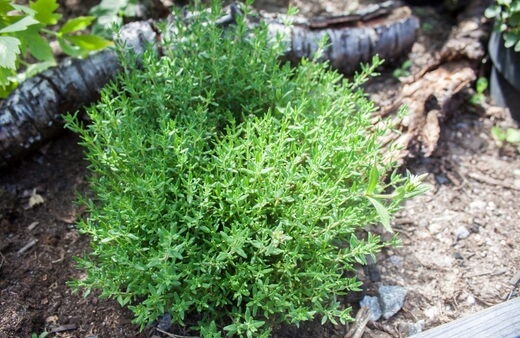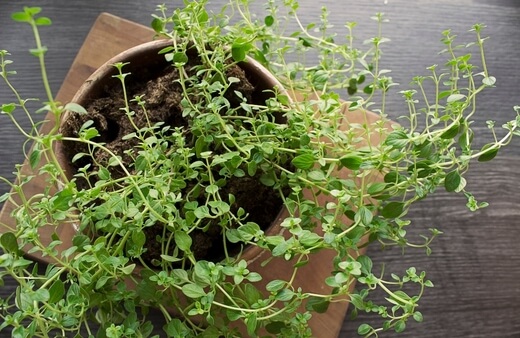When I smell thyme, I am instantly transported back to my grandmother’s kitchen and my favourite meat dish that she used to prepare. This herb packs a punch considering it can be ornamental, medicinal, or a flavour enhancer for food.
Our growing guide pays homage to this woody shrub with a very long and rich history. Learn how to propagate thyme and once you have successfully nurtured and grown your seedlings, how to care for your plant to keep it happy.
More...

Family: | Lamiaceae |
|---|---|
Genus: | Thymus |
Species: | Various |
Common Names: | Common thyme, English thyme, Summer thyme, French thyme, Winter thyme, German thyme |
Origin: | Mediterranean |
Location: | Indoor and outdoor |
Type: | Herb |
Growth: | Up to 40 cm tall and wide |
Sun requirements: | Full sun |
Foliage Colour: | Green |
Flower Colour: | Purple |
Flowering: | Spring, early summer |
Fruits: | Small dark brown seeds |
Maintenance level: | Low |
Poisonous for pets: | No |
Introducing Thyme
Thyme is a herb you are probably familiar with, especially if you think of its scent. Every part of the plant can be used in cooking but is also a fantastic medicinal helper, particularly to help cure bacterial and fungal infections. It is part of the mint or Lamiaceae family
When we think about the use of thyme in cuisine, it really is something used around the world and if you think of your local supermarket, you can always find fresh or dried thyme readily available. Thyme is wonderfully hardy and can be grown indoors or outdoors.

History of Thyme
Thyme has a rich and interesting history that dates back to the ancient Mediterranean. Now this herb is known the world over and used in cuisine internationally. Before thyme was used for food purposes, it had other uses.
Egyptians used it for embalming thanks to its antiseptic qualities, and the Romans used it to symbolise bravery. They would pin thyme onto themselves before going into battle and also used to burn it in their homes and places of worship.
Popular Thyme Varieties
Just to clarify, the name Thyme refers to many different herbs that are part of the Thymus genus, which includes more than 350 species. The most common one is Thymus vulgaris with popular varieties being English, French, and German thyme.
English or Common Thyme
This is a thyme that is often dried for use in cooking. It has a stronger flavour than French and German thyme and is great to season meat and stews. English thyme produces little purple flowers, has pointy leaves, and red stems. It grows to a height of 40 cm and can spread out up to 40 cm.
French or Summer Thyme
This variety has a more subtle flavour than the English variety and works well with dishes like seafood. Its height and spread is around 30 cm and it doesn’t handle cold as well as the other varieties.
German or Winter Thyme
This is much like the English kind. It handles cold better than English and French thyme, and has round leaves without red stems. The flavour profile is somewhere in between the other two and it grows to the same size as English thyme.
Also, be sure to check out our comprehensive guide on growing creeping thyme which is perfect for low-maintenance gardens.
How to Grow Thyme in Australia

Propagating Thyme
Thyme Propagation by Cuttings
Aim for a thyme cutting that is around 7.5 cm and take it from the top of a stem. Take off all leaves on the lower third of the cutting and then dip into rooting hormone. You can then plant your cuttings in a well-draining potting mix to a depth of at least 2.5cm.
Our recommended potting mixes are a mixture of sand with a third potting soil or vermiculite. Aim to keep the soil moist but make sure it doesn’t get soggy. You should start to see signs of new growth in about 4 to 6 weeks, which means that root development has also taken place.
You can now transplant the seedlings into the garden or into pots as required. If you are transplanting outdoors, aim to do so during spring.


Get Your Free Guide:
Master Growing Australian Natives eBook
A Must Have Complete Guide for Every Australian Garden
Get Your Free Guide:
Master Growing Australian Natives eBook
A Must Have Complete Guide for Every Australian Garden
Propagating Thyme by Layering
When the stems of the thyme plant touch the ground, they start the process of sending out roots which means you can propagate by layering. Choose a long stem of the plant and secure it to the soil with some kind of stake. There needs to be at least 10 cm from the tip of the stem to the stake you are using.
You’ll see that the tip starts to grow upwards from the stake and within 4 weeks, there should be roots that have formed. When the new plant seems to be rooted enough, you can then cut it off from the rest of the plant. You can now dig up the plant and transplant it into the garden or pot.
Propagating Thyme by Division
For the division method, you’ll need to select stems that are woody. You’re aiming for two stems for each root section. Use a sharp knife to cut the roots for each section required. You can now plant these sections in the garden or pots.
Just make sure the entire root system is below the ground when planting. We recommend mulching if you are planting in the garden.
How to Propagate Thyme Using Seeds
You can grow thyme quite well from seed. The ideal time to harvest the seeds is during autumn after the flowers have dried and the seed heads become brown. Seeds are best germinated indoors and should be exposed to indirect light and a temperature around 21°C.
Prep trays with moist seed starting mix and sow the seeds just on the surface that they are only just covered. Germination can be unpredictable so plant more seeds than the actual number of plants you hope to produce.
Remember to keep your soil moist but never soggy. A good idea is to use a spray bottle for watering to help control moisture levels. Germination should take place in 14 to 28 days.
Best Conditions for Planting Thyme
- Sunlight - Thyme enjoys full sun. It does come from the Mediterranean after all, so any conditions that best match its native home will keep it happy. It is possible to grow thyme indoors if it gets enough light. A guideline is a minimum of 6 hours of direct light each day. 8 hours is even better.
- Soil - Dry, sandy, and rocky soil that is well-draining is the order of the day for Thyme. Aim for a neutral pH but the plant can handle between 6.5 and 8.5.
- Watering - Thyme is a drought resistant plant and you should only water it when the soil is dry.
- Pruning - Thyme responds well to pruning as it helps with new growth and development. The plant will look fuller and the more pruning you do, the quicker it will grow. When doing your pruning, make sure that you don’t remove more than a third of the plant and to weed your thyme often.
- Fertiliser - Thyme doesn’t need much fertiliser and can do without it entirely. If you use a fertiliser that has too much nitrogen, it might sacrifice the flavour of the plant although it does speed up growth.
If you feel your soil isn’t providing enough nutrients, you can use a weak fertiliser that has low nitrogen and apply it at the start of the growing season.
How to Use and Store Thyme

Fresh vs Dried Thyme
Dried thyme tastes pretty much the same as fresh thyme once it has been hydrated again during cooking. Dried thyme can be used instead of fresh thyme in any dish, but you can use about a third of the amount that you would use compared to the fresh herb.
Cooking with Thyme
Fresh thyme has a strong herb flavour with notes of grass, wood and floral. It could easily be compared to lavender and rosemary. When cooking with thyme, you can use a whole stem, or a few leaves that have been picked off the plant.
If you want to release a lot of flavour, allow the herb to cook for longer. If you are using the whole stem, once you’ve finished cooking with them, you’ll need to remove from the dish before eating.
How to Store Thyme
You can store fresh thyme in a damp paper towel that is then sealed off in a plastic bag. It can last in the fridge for up to 2 weeks but you’ll need to throw it away when the leaves start turning brown. If you are removing thyme leaves from the stem, they can keep their freshness in a sealed container for around 3 days in the fridge.
If you are wanting to store dried thyme, you can seal it off in a glass or plastic holder and keep it somewhere cool and dark. In these conditions, your dried thyme can last up to 3 years.
Common Thyme Pests and Diseases
Aphids
Aphids love to hang out on the underneath side of leaves or otherwise on stem tips. They literally suck the life out of the plant but also spread disease.
You can create a mixture of one part rubbing alcohol and one part water, dip a cloth into it, and wipe down the affected leaves and stems. You can follow this with a neem oil spray and follow this routine each week until the infestation disappears.
Spider Mites
A telltale sign of spider mites is when you notice a delicate web that covers the leaves and stems of your thyme plant. Much like aphids, they suck the sap from your plant and the method of treatment would be the same as for aphids.
Fungal Disease
Thyme can sometimes be attacked by fungal diseases. These include botrytis rot, root rot, and Alternaria blight. These funguses thrive in warm and damp conditions.
If you do find that your thyme plant is struggling with any of these, you’ll need to prune off any infected parts of the plant using a clean and sharp instrument. We recommend bottom watering your plant from a tray placed underneath if growing in a pot, or at the plant base if in the garden. Make sure you don’t get any water on the leaves.
It’s a good idea to prune the plant and help it grow in an upright position. This helps with air circulation. Adding mulch to the plants also means that fungal spores won’t splash onto the plant leaves.
Try and give the soil a chance to dry out during the day. If you are going to be doing any watering, aim for early in the morning.
Thyme Frequently Asked Questions

When was thyme first discovered?
The use of thyme dates back to 2750 BC. Through deciphering Sumerian cuneiform tablets, it was discovered that thyme was dried and then mashed together with water, pears, and fig to create a poultice.
What are some of the early uses of thyme?
In ancient Egypt, thyme was used for embalming and the belief was that it helped the person pass to the next life. Ancient Romans thought that thyme was a cure for poison, and emperors used it for their baths and cooking.
During the Middle Ages, soldiers were given bouquets of thyme when they were heading into battle. Before modern medicine existed, thyme oil was used to prepare bandages as it’s naturally antiseptic.
When is the best time to harvest thyme?
The great thing about growing your own thyme is you can just help yourself to a sprig of it when you need it. If you are wanting to harvest a bigger quantity, the best time to do this is summer, just before the flowers appear.
This is when you get the best flavour. Be sure to harvest your thyme early in the morning because this is when the essential oils are at their peak.
How can you best preserve thyme?
You can make your thyme last longer by drying it, freezing it, or even infusing it in oil.
What vitamins and minerals are found in thyme?
Thyme is full of vitamin C and vitamin A, but is also rich in iron, copper, calcium, manganese, riboflavin and fibre.
What are the medicinal uses of thyme?
There are many medicinal uses for thyme. In traditional medicine, thyme is used to treat depression, epilepsy, and headaches. Thyme contains active ingredients like thymol and carvacrol. These have antioxidant, anti-inflammatory, and antiseptic qualities.
Thymol in particular, which is extracted from thyme oil, is used in mouthwashes, hand sanitizers, and treatments for acne as its antibacterial.
Looking for more gardening inspiration and advice? Sign up for our newsletter.
Wrapping Up Our Thyme Growing Guide
Aside from the amazing culinary uses of thyme, it’s also a landscaping delight. You can use it as a fast growing ground cover or even a border plant. Thyme is quite good at keeping pests away, and attracts some helpful visitors to the garden like bees who can help to pollinate other plants, but also ladybugs that eat up all the aphids. Thyme is a low maintenance plant that has a lot to offer.
Published on March 23, 2023 by Maisie Blevins
Last Updated on February 25, 2024




